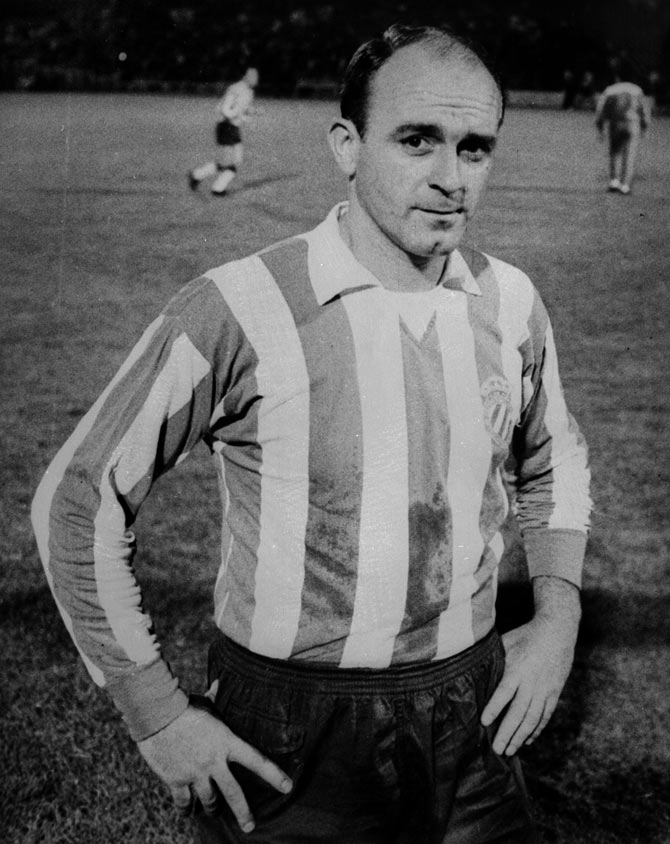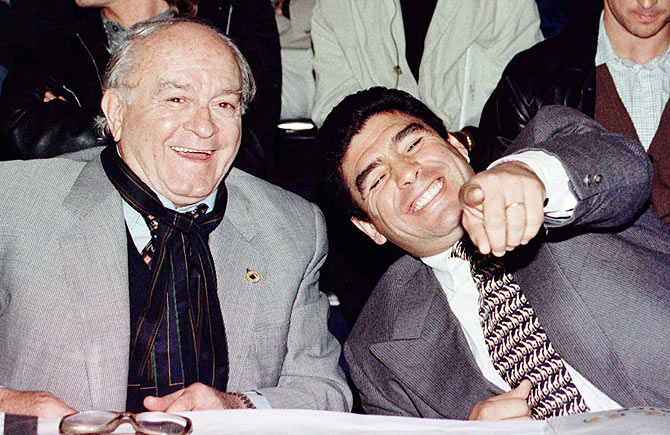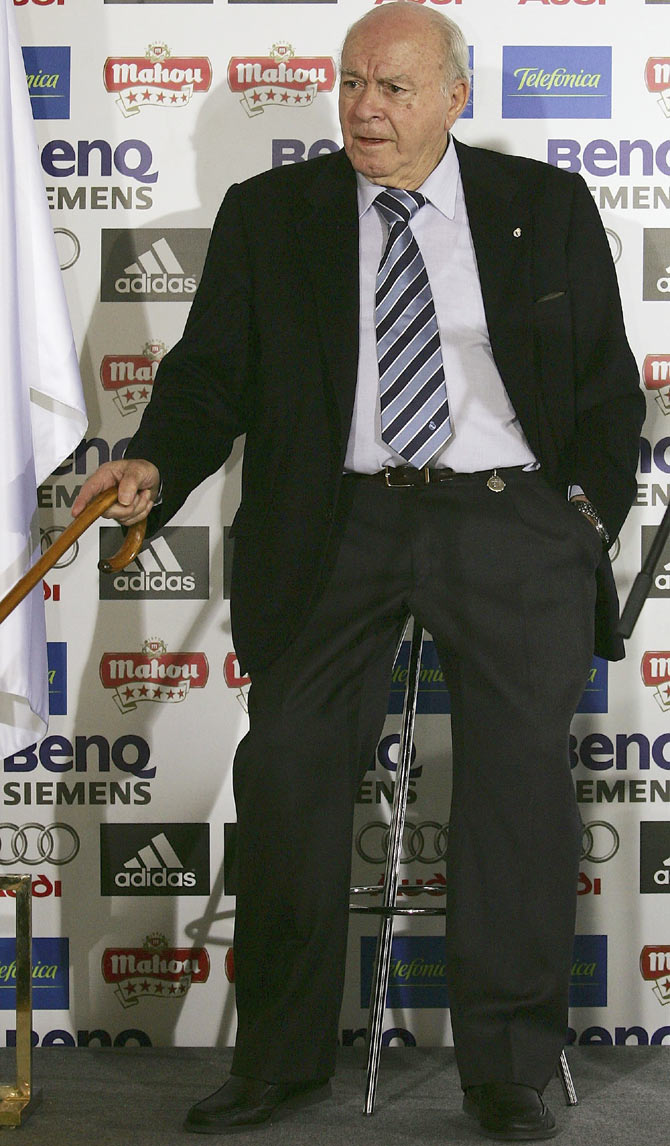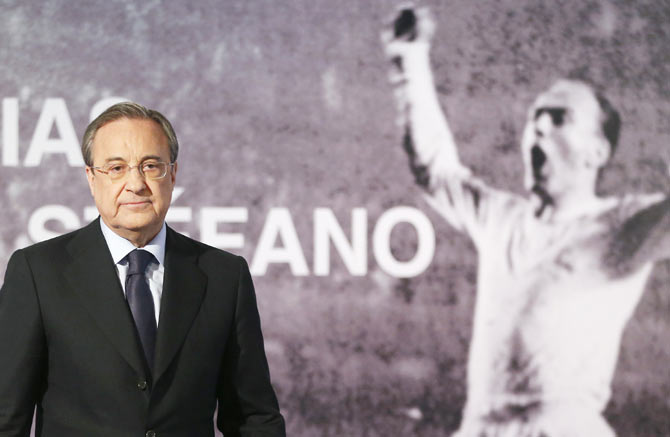 | « Back to article | Print this article |
Tribute: Real great and 'complete player' Di Stefano leaves a lasting legacy
Frequently bracketed with Pele and Diego Maradona among the greatest exponents of the game, Alfredo Di Stefano, who died on Monday, aged 88, was one of the most complete footballers of all time.
An accomplished defender, a midfield workhorse, a playmaker and a prolific striker, he could be seen covering back in defence, charging through the midfield, laying on goals for the forwards and smashing shots into the net all in the same game.
Known as "La Saeta Rubia" (the blond arrow), Di Stefano's achievements as a player helped turn Real Madrid, the Spanish club he joined in 1953, into one of the world's leading sides.
He transformed them from insignificant underachievers into the kings of the continent when he guided them to five successive European Cups between 1956 and 1960, scoring in each of the finals.
"People argue between Pele or Maradona," Pele was quoted as saying in Spanish media in late 2009.
"For me, Di Stefano is the best. He was much more complete."
- Please click NEXT to read more...
'I tried my hardest and people rewarded me with applause'
Di Stefano was the progenitor of "total football" and years ahead of his time in terms of his approach to his professional career. In modern parlance, he was the first "Galactico".
Prepared to play for the highest bidder, he was also accused by some of being a footballing mercenary.
He mixed with the rich and famous, was the star of a film about himself and the victim of a dramatic kidnapping in Venezuela.
Gruff, egocentric, impatient and with a wry sense of humour, he did not suffer fools gladly.
But above all Di Stefano was a brilliant footballer and fierce competitor who left an indelible mark on the history of the game.
"I always felt like I had a job to do and that means you have to perform to perfection," Di Stefano said in an interview with Spanish soccer weekly Don Balon in October 2010.
"I tried my hardest and people rewarded me with applause."
- Please click NEXT to read more...
He won two league titles and steered Argentina to victory in the Copa America
Twice European Footballer of the Year in 1957 and 1959, Di Stefano scored 418 goals in 510 official games for Real Madrid.
The eldest of three brothers, he was born of Italian parents and brought up on the outskirts of Buenos Aires where he had to shoulder the main burden of work on the family farm, something which may go some way to explaining his legendary stamina.
"If I lived my life over again I would stay in the countryside," he told Don Balon.
"I prefer the countryside, the milking of the cows and the sheep," he said, adding that he would only have played friendly soccer matches and would not have become a professional.
Di Stefano signed for River Plate at the age of 15, making his debut for the first team two years later. He won two league titles and steered Argentina to victory in the Copa America at the age of 20, scoring six goals in six games.
He then joined the exodus of talented Argentines attracted by the high wages paid in the Colombian league when he was lured to Millonarios of Bogota in 1949 and also made a handful of appearances for Colombia.
- Please click NEXT to read more...
Transformed Real Madrid into a dominant force in European football
He caught the eye in Spain when he played in an exhibition match as part of Real's 50th anniversary celebrations in 1952 and became the object of one of the most controversial transfer sagas in the history of Spanish football as Real and Barcelona became involved in a tug of war to secure his services.
Depending on which side of the fence you stand, Real got their man in the end either because they were sharper operators or because of official connivance from the government.
General Franco's right-hand-man General Moscardo brokered a deal whereby the two clubs would share the player, spending alternate seasons with each one starting at Real, but Barca eventually backed out.
Di Stefano transformed Real from a club that had only won two league titles in the previous 50 years, the last in 1936, into the dominant force in Spanish and European football.
- Please click NEXT to read more...
Di Stefano also had a distinguished career as a coach
They went on to win five consecutive European Cups, eight league titles and the first Club World Cup in 1960, with Di Stefano leading the way alongside other greats Ferenc Puskas, Raymond Kopa, Paco Gento and Hector Rial.
He eventually left Real after 11 seasons having fallen out with President Santiago Bernabeu and returned to Barcelona to play for Espanyol, retiring two seasons later at the age of 40, 22 years after making his debut for River Plate.
Although largely known for his remarkable achievements as a player, Di Stefano also had a distinguished career as a coach.
He managed Argentina's two biggest teams, Boca Juniors and River Plate, leading each club to a league title and also guided Valencia to only their fourth Spanish championship in 1971 and to victory in the European Cup Winners' Cup in 1980.
He returned to Real Madrid to take over as coach between 1982 and 1984, with the side finishing as runners-up in the title race in consecutive seasons.
- Please click NEXT to read more...
'Football is about comradeship'
Florentino Perez's decision to make him honorary president of Real Madrid in 2000 was just recognition for a player who had put the club on the European soccer map in the 1950s.
His international career was less dazzling.
He scored 23 goals in 31 games for Spain, remarkably the third country he represented, but for a variety of reasons never graced a World Cup, missing the 1962 tournament due to injury.
He had several health problems in his later years and was often seen in a wheelchair in public. Di Stefano was fitted with a pacemaker in 2005 following heart surgery.
Asked by Don Balon what advice he would give young football hopefuls, he said they should listen to their coaches.
"There is one part you have to understand: that all this is about comradeship, team and not a personal thing.
"There are some who when they play football they carry the ball ta-ta-ta, but they are jugglers not footballers.
"The less you have the ball at your feet the better."

© Copyright 2025 Reuters Limited. All rights reserved. Republication or redistribution of Reuters content, including by framing or similar means, is expressly prohibited without the prior written consent of Reuters. Reuters shall not be liable for any errors or delays in the content, or for any actions taken in reliance thereon.





